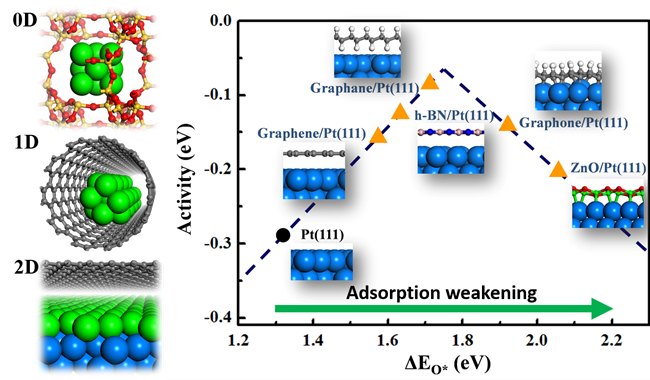The research group led by Profs. FU Qiang and BAO Xinhe from Dalian Institute of Chemical Physics of the Chinese Academy of Sciences revealed both geometric constraint and confinement filed in two-dimensional (2D) space between graphene overlayer and Pt(111). They demonstrated a new concept of confined catalysis under 2D materials “catalysis under cover”. These findings were published in the latest issue of PNAS, entitled "Confined catalysis under two-dimensional materials”.
Small spaces in nanoreactors may have big implications in chemistry. Chemical nature of molecules and reactions within the nanospaces can be changed significantly due to the nanoconfinement effect. Understanding the fundamentals of confined catalysis has become an important topic in heterogeneous catalysis. 2D nanoreactor formed under 2D materials can provide a well-defined model system to explore the confined catalysis.
Scientists thus chose graphene/Pt(111) surface as a model system to study confined catalysis using density functional theory (DFT) calculations. They revealed that adsorption of atoms and molecules on the Pt(111) surface has been weakened under the graphene. A similar result has been found on Pt(110) and Pt(100) surfaces covered with graphene. Both geometric constraint and confinement field imposed by the 2D cover have been attributed to the observed confinement phenomena.

Schematic illustration of 0D, 1D and 2D nanoreactors and modulation of Pt-catalyzed ORR reaction by placing 2D covers atop (Image by FU Qiang)
The general tendency for weakened surface adsorption under the confinement of graphene overlayer enables feasible modulation of surface reactions by placing a 2D cover. The developed concept “catalysis under cover” can be applied to reactions between two opposite 2D walls interacting with each other through van der Waals force. It helps to design high-performance nanocatalysts interfacing with 2D material overlayers.
They have demonstrated the confinement-induced modulation of surface reactivity in Pt-catalyzed oxygen reduction reaction (ORR) under 2D covers. It has been known that oxygen binding on Pt is relatively strong and all routes to weaken the binding can be applied to promote the reaction. When placing different 2D materials such as graphene and h-BN on the surface, oxygen binding with Pt has been weakened which effectively enhances the ORR activity.
The confined catalysis under 2D materials can be applied to supported nanocatalysts. Metal nanoparticles may be encapsulated by 2D materials forming core-shell nanostructures. The active core structures are well protected by the outer shells and catalyst stability is improved. Furthermore, the catalyst activity can be enhanced by the confinement of the outer shells.
The study was supported by the National Natural Science Foundation of China, Ministry of Science and Technology of China, Strategic Priority Research Program of the Chinese Academy of Sciences, and Collaborative Innovation Center of Chemistry for Energy Materials. (Text and Image by FU Qiang) (CN约稿)
EMBARGOED: 3 p.m. ET Monday, May 22, 2017
Dr. LU Xinyi
Dalian Institute of Chemical Physics, Chinese Academy of Sciences,
457 Zhongshan Road, Dalian, 116023, China,
Tel: 86-411-84379201
E-mail: luxinyi@dicp.ac.cn